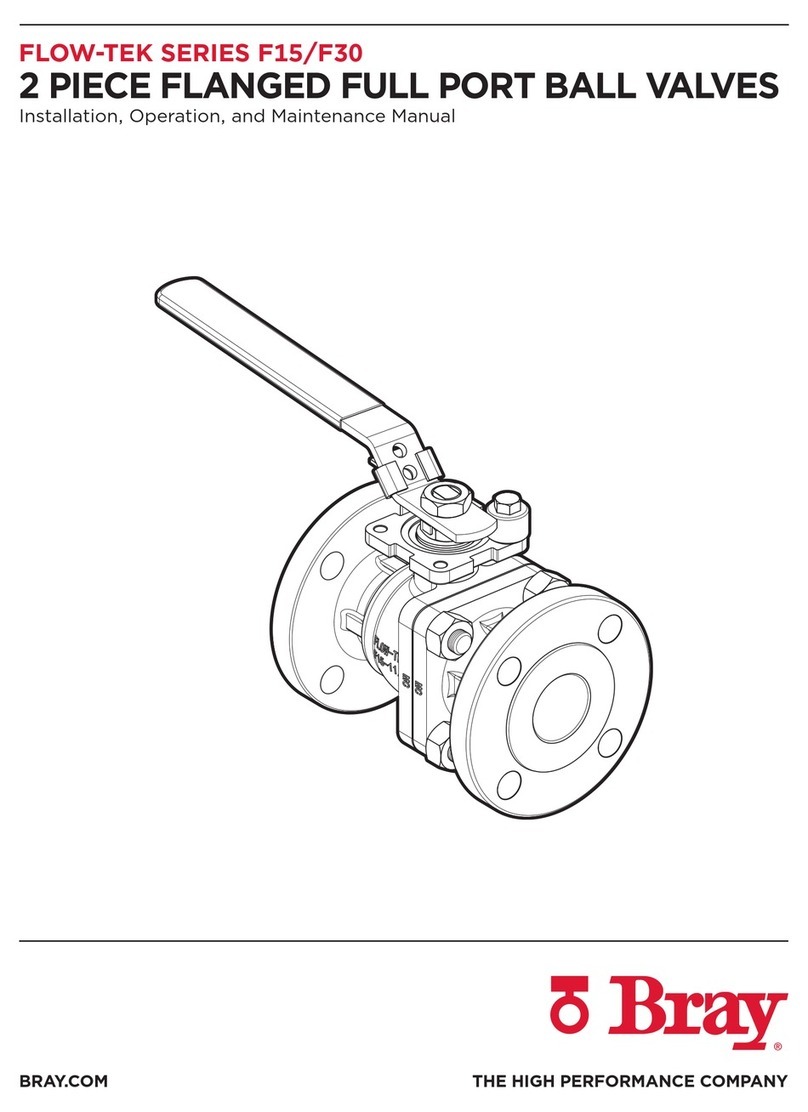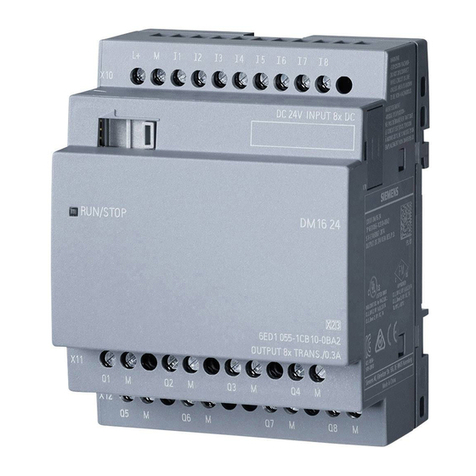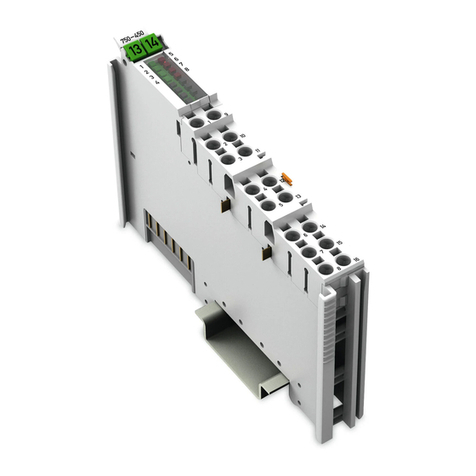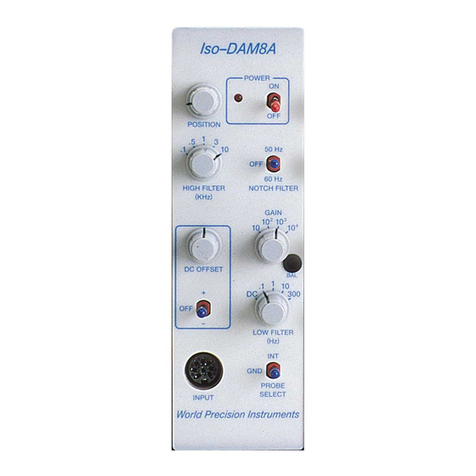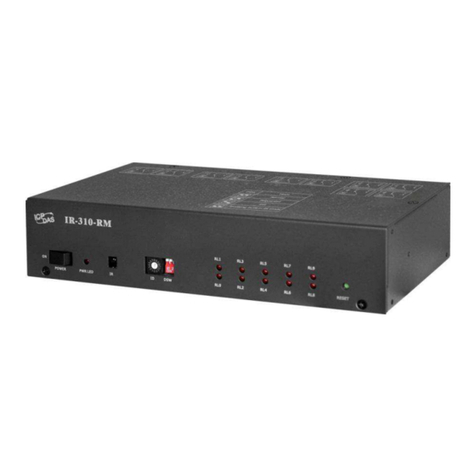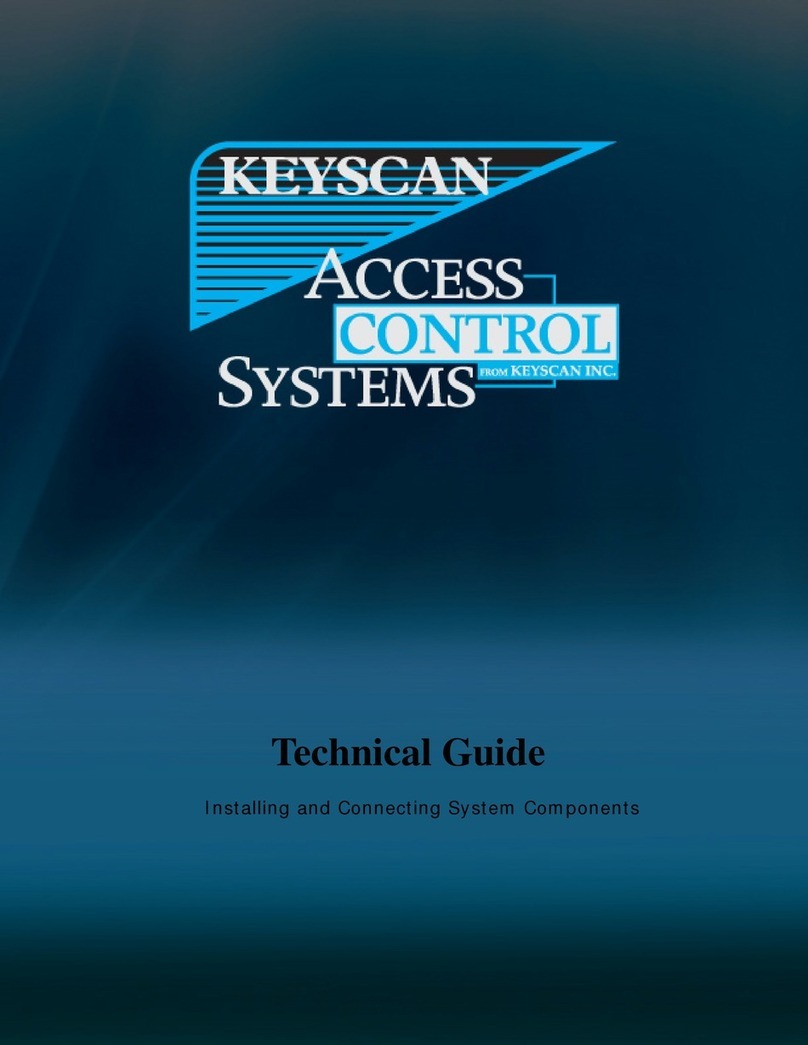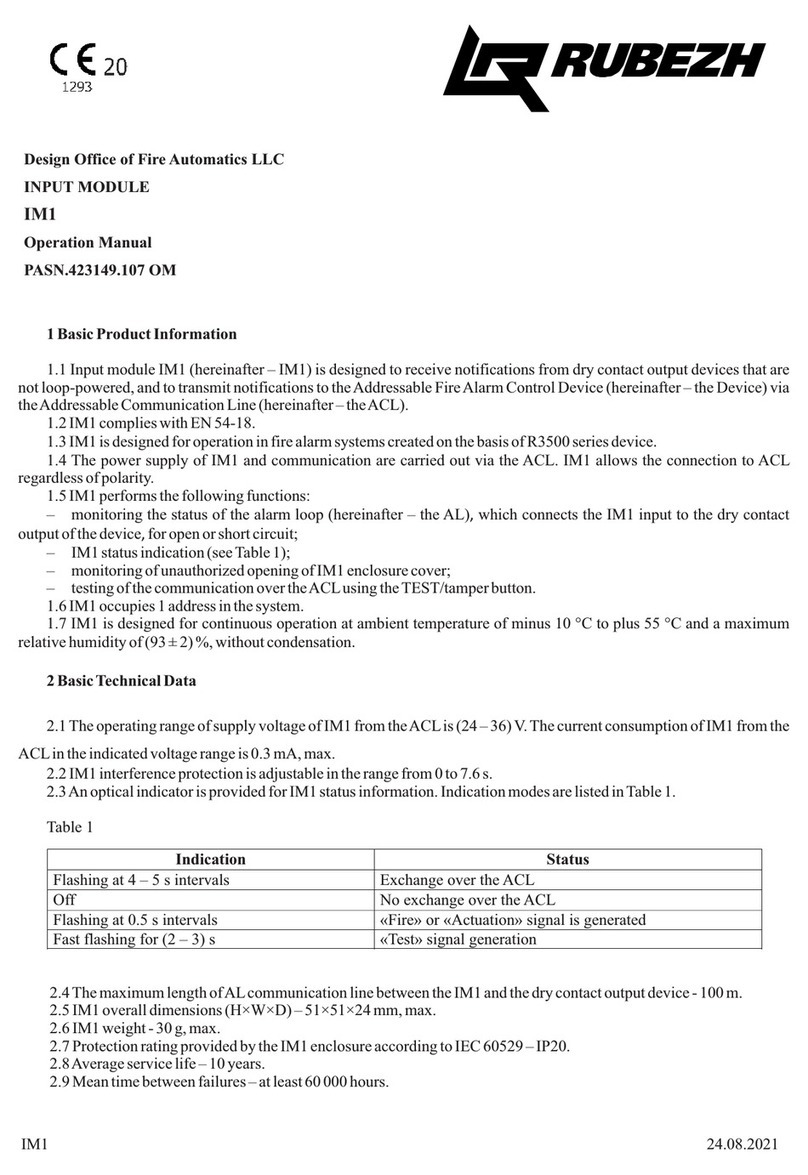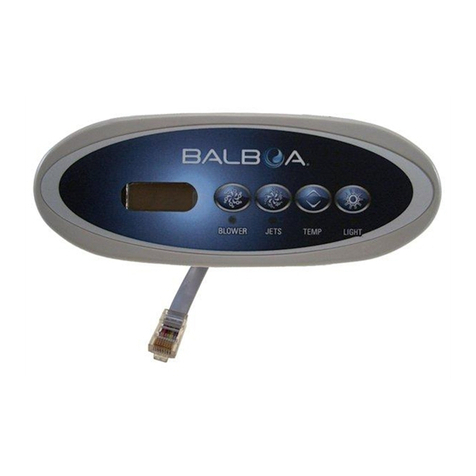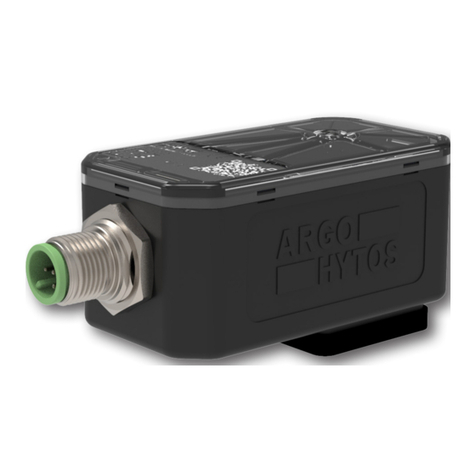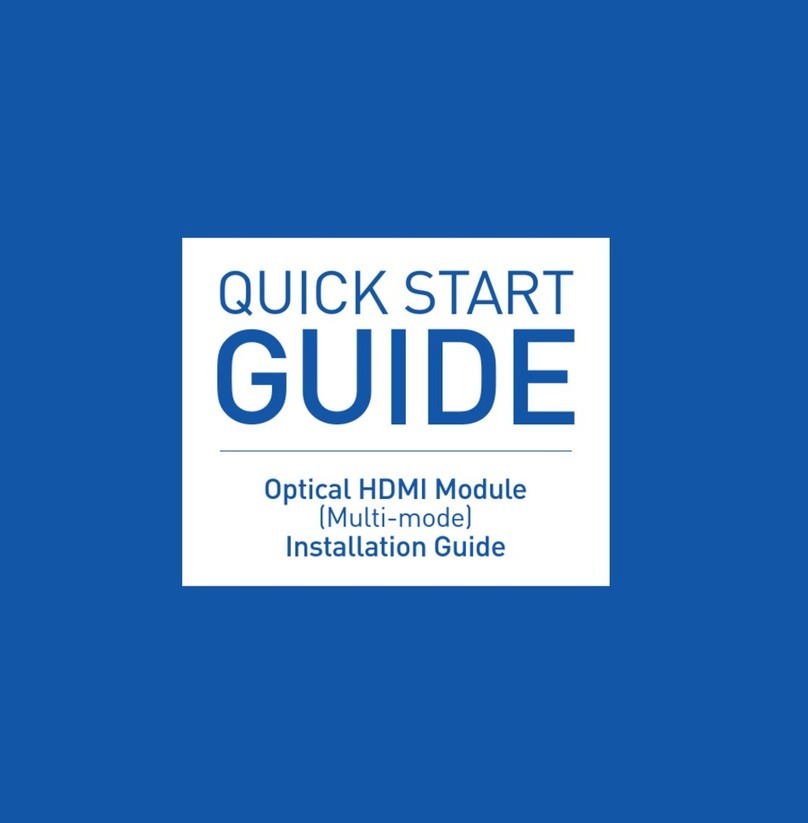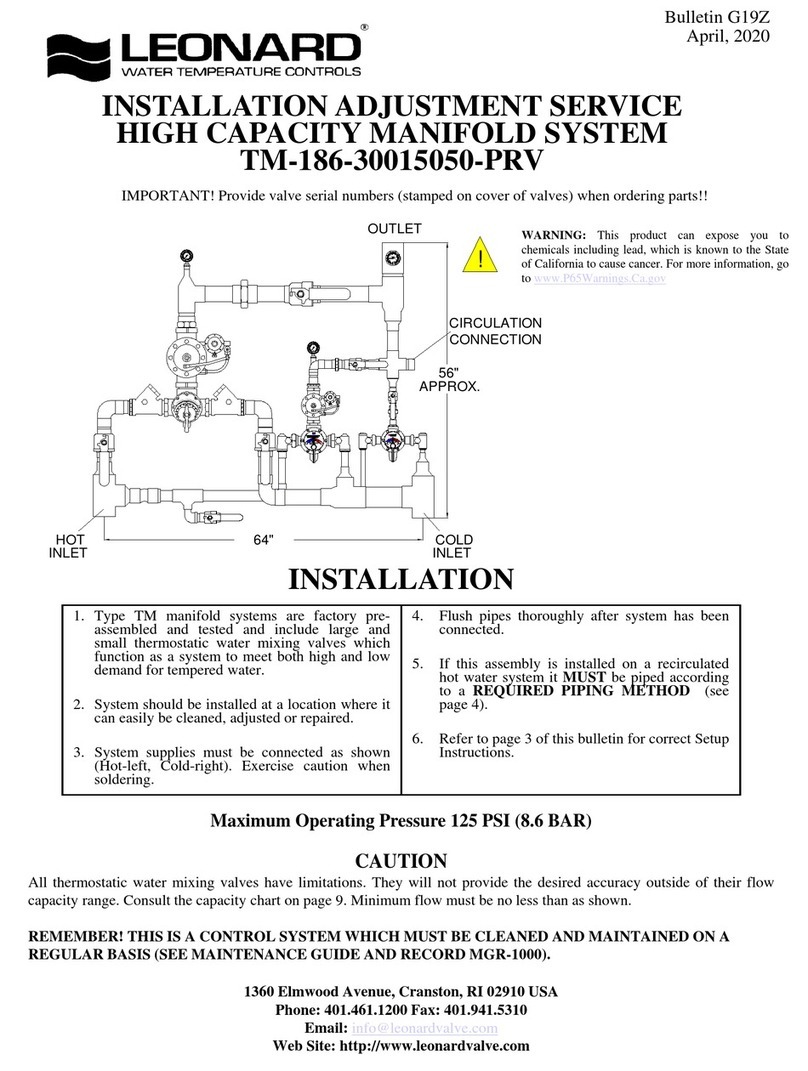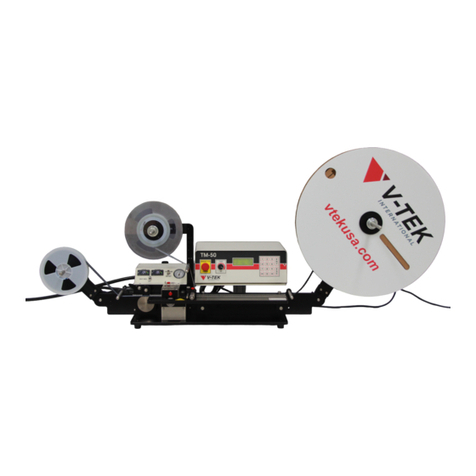Bray 950 Series User manual

SERIES 950
UNIDIRECTIONAL KNIFE GATE VALVES
Installation, Operation and Maintenance Manual
BRAY.COM THE HIGH PERFORMANCE COMPANY

SERIES 950 UNIDIRECTIONAL KNIFE GATE VALVE
Installation, Operation and Maintenance Manual
© 2020 BRAY INTERNATIONAL. ALL RIGHTS RESERVED. BRAY.COM The Information contained
herein shall not be copied, transferred, conveyed, or displayed in any manner that would violate its
proprietary nature without the express written permission of Bray International, Inc.
2 of 22
TABLE OF CONTENTS
1.0 Definition of Terms 3
2.0 Hazard Free Use 3
3.0 Introduction 4
4.0 Parts Identification 5
5.0 Valve Identification 6
6.0 Lifting The Valve 7
7.0 Storage 8
8.0 Installation 11
9.0 Lockout 14
10.0 Maintenance 15
11.0 Packing Replacement | Manual Valves 15
12.0 Packing Replacement | Cylinder Operated Valves 16
13.0 Seat Replacement 18
14.0 Retro Fitting Cylinder Actuator 19
15.0 Troubleshooting 20
16.0 Return Merchandise Authorization 21

SERIES 950 UNIDIRECTIONAL KNIFE GATE VALVE
Installation, Operation and Maintenance Manual
© 2020 BRAY INTERNATIONAL. ALL RIGHTS RESERVED. BRAY.COM The Information contained
herein shall not be copied, transferred, conveyed, or displayed in any manner that would violate its
proprietary nature without the express written permission of Bray International, Inc.
3 of 22
0.00 Identifies and explains sequential procedure to be performed.
NOTE: Provides important information related to a procedure.
CAUTION
Indicates a potentially hazardous situation which, if not avoided, may
result in injury.
NOTICE
Used without the safety alert symbol, indicates a potential situation
which, if not avoided, may result in an undesirable result or state,
including property damage.
WARNING
Indicates a potentially hazardous situation which, if not avoided, could
result in death or injury.
1.0 DEFINITION OF TERMS
READ AND FOLLOW THESE INSTRUCTIONS CAREFULLY.
SAVE THIS MANUAL FOR LATER USE.
2.0 HAZARD-FREE USE
2.1 This device left the factory in proper condition to be safely
installed and operated in a hazard-free manner. The notes and
warnings in this document must be observed by the user if this
safe condition is to be maintained and hazard-free operation of the
device assured.
2.2 Take all necessary precautions to prevent damage to the valve
due to rough handling, impact, or improper storage. Do not use
abrasive compounds to clean the valve, or scrape metal surfaces
with any objects
2.3 The control systems in which the valve is installed must have
proper safeguards to prevent injury to personnel, or damage to
equipment, should failure of system components occur.

SERIES 950 UNIDIRECTIONAL KNIFE GATE VALVE
Installation, Operation and Maintenance Manual
© 2020 BRAY INTERNATIONAL. ALL RIGHTS RESERVED. BRAY.COM The Information contained
herein shall not be copied, transferred, conveyed, or displayed in any manner that would violate its
proprietary nature without the express written permission of Bray International, Inc.
4 of 22
2.4 QUALIFIED PERSONNEL
2.4.1 A qualified person in terms of this document is one who is familiar
with the installation, commissioning, and operation of the device
and who has appropriate qualifications, such as:
2.4.1.1 Is trained in the operation and maintenance of electrical equipment
and systems in accordance with established safety practices.
2.4.1.2 Is trained or authorized to energize, de-energize, ground, tag, and
lock electrical circuits and equipment in accordance with established
safety practices.
2.4.1.3 Is trained in the proper use and care of personal protective
equipment (PPE) in accordance with established safety practices.
2.4.1.4 In cases where the device is installed in a potentially explosive
(hazardous) location – is trained in the commissioning, operation,
and maintenance of equipment in hazardous locations.
2.5 Additional information about Series 950 Unidirectional Knife Gate
Valve — including application data, engineering specifications, and
actuator selection — is available from your local Bray distributor or
sales representative.
3.0 INTRODUCTION
3.1 The Bray Series 950’s single piece, cast body design offers
rugged performance in applications ranging from general
purpose to severe media handling in an economical semi-lug
body. Available with integral metal or replaceable soft seat, the
Bray Series 950 knife gate valve is easily automated for on/off
applications.

SERIES 950 UNIDIRECTIONAL KNIFE GATE VALVE
Installation, Operation and Maintenance Manual
© 2020 BRAY INTERNATIONAL. ALL RIGHTS RESERVED. BRAY.COM The Information contained
herein shall not be copied, transferred, conveyed, or displayed in any manner that would violate its
proprietary nature without the express written permission of Bray International, Inc.
5 of 22
Item Description
1 Body
2Gate
3 Packing Set
4 Gland
5 Gland Bolt
6 Gland Washer
7 Gland Nut
8 Side Plate
9 Mounting Bolt (Top)
10 Mounting Nut (Top)
11 Mounting Nut (Bottom)
12 Spring Washer
13 Clevis
14 Stem
15 Clevis Bolt
16 Clevis Nut
17 Collar
18 Yoke Sleeve
19 Grease Nipple
20 Thrust Washer
21 Hand Wheel
22 Socket Screw
23 Seat1
4.0 PARTS IDENTIFICATION
Figure 1: Series 950 Exploded View
NOTE
1 Optional replaceable resilient seat.
22
21
19
18
14
16
15
2
8
1
5
10
11
12
9
23
4
3
6
7
13
17

SERIES 950 UNIDIRECTIONAL KNIFE GATE VALVE
Installation, Operation and Maintenance Manual
© 2020 BRAY INTERNATIONAL. ALL RIGHTS RESERVED. BRAY.COM The Information contained
herein shall not be copied, transferred, conveyed, or displayed in any manner that would violate its
proprietary nature without the express written permission of Bray International, Inc.
6 of 22
5.0 VALVE IDENTIFICATION
5.1 Valve size and brief material specification of body (markings such
as “SS” or “DI”) are marked on the valve body.
5.2 A stainless steel nameplate (below) affixed to the yoke of the
valve contains most of the relevant information on the valve that
includes a unique serial number of the valve.
NOTE: Please reference the valves serial number when inquiring
for spare parts.
5.3 All Series 950 Knife Gate valves are provided with an identification
tag (Figure 2) printed with the following data:
>SERIAL NUMBER: Unique serial number of valve.
>SIZE: Valve size e.g. 6 in/150 mm.
>MODEL: Series number of the valve.
>FLG. DRILL: Flange Drill e.g. ASME B16.5 CL150.
>BODY: Material grade of body e.g. CF8 (304) etc.
>GATE: Material grade of gate e.g. 304 Stainless Steel.
>SEAT: Material of seat e.g. Buna-N.
>PACKING: Material of packing e.g. PTFE w/EPDM Quad Seal.
>CWP: Maximum permissible pressure in psi/bar(g)
>MAX TEMP: Maximum temperature in °F/°C
SERIAL NUMBER
SEAT PACKING CWP MAX TEMP
MODEL FLG. DRILL BODY GATE
SIZE
Figure 2: Identification tag.
NOTICE
Ensure the box is not damaged externally. Remove the valve from the
packaging and check for any damage to the valve and its components
during transit. Report any damage or discrepancies immediately.

SERIES 950 UNIDIRECTIONAL KNIFE GATE VALVE
Installation, Operation and Maintenance Manual
© 2020 BRAY INTERNATIONAL. ALL RIGHTS RESERVED. BRAY.COM The Information contained
herein shall not be copied, transferred, conveyed, or displayed in any manner that would violate its
proprietary nature without the express written permission of Bray International, Inc.
7 of 22
6.1 The points below are for reference purposes only, use safe and
proper lifting and support techniques. DO NOT lift valves with
any adjoining pipe or other equipment attached. Lift with
properly rated lifting equipment. Follow jurisdictional safety
requirements.
6.2 Suggested lifting points are as shown below to lift valve assemblies
that are in a horizontal orientation. Eye bolts in flange through
holes can be used to lift the valve body or, for 2” through 12”
valves, a sling can be strapped around the top of the valve body.
6.3 KNIFE GATE VALVE WITH BEVEL GEAR ACTUATOR:
For valves with bevel gear actuators, a sling or chain can be
wrapped around the bevel gear actuator body, between the
mounting plate and the input shaft housing. This would be in
conjunction with lifting from the valve body as well. See Figure 3.
Figure 3: Knife Gate Valve with Bevel Gear Actuator,
Horizontal Lifting
6.4 KNIFE GATE VALVE WITH PNEUMATIC CYLINDER ACTUATOR:
For valves with pneumatic cylinder actuators, a sling can be
wrapped around the cylinder, near the cylinder head (piston rod
end). This would be in conjunction with lifting from the valve body.
See Figure 4.
6.4.1 Utilize caution to not bump, dent or damage the cylinder tube.
6.4.2 DO NOT utilize the cylinder tie-rod ends to lift.
Figure 4: Knife Gate Valve with Pneumatic Cylinder Actuator,
Horizontal Lifting
6.0 LIFTING THE VALVE
WARNING
A potential hazard exists with handling valves. Failure to handle valves
properly may cause a valve to shift, slip or fall causing serious injury or
death and/or equipment damage.

SERIES 950 UNIDIRECTIONAL KNIFE GATE VALVE
Installation, Operation and Maintenance Manual
© 2020 BRAY INTERNATIONAL. ALL RIGHTS RESERVED. BRAY.COM The Information contained
herein shall not be copied, transferred, conveyed, or displayed in any manner that would violate its
proprietary nature without the express written permission of Bray International, Inc.
8 of 22
Figure 8: Knife Gate Valve with
Handwheel, Vertical Lifting
Figure 7: Knife Gate Valve with
Pneumatic Cylinder Actuator,
Vertical Lifting
Figure 6: Knife Gate Valve w/Bevel
Gear Actuator, Vertical Lifting
6.5 KNIFE GATE VALVE WITH HANDWHEEL ACTUATOR:
For valves with handwheel actuators, a sling or chain can be
wrapped through the rim of the handwheel. For chainwheel
actuators, a sling can be wrapped in the area between the yoke/
legs and the chainwheel/guide assembly. This would be in
conjunction with lifting from the valve body as well. See Figure 5.
Figure 5: Knife Gate Valve with Handwheel, Horizontal Lifting
6.6 Suggested lifting options are as shown below to lift valve
assemblies that are in a vertical orientation. For valves with bevel
gear actuators, wrap slings or chains around the top of each leg.
NOTE: Use caution not to put any side load on the bevel gear input
shaft or on the valves threaded stem. See Figure 6.
6.7 For valves with pneumatic cylinder actuators, wrap slings around
the top of each leg. Use caution to not bump, dent or damage the
cylinder tube and avoid any side load on the cylinder piston rod.
NOTE: DO NOT utilize the cylinder tie-rod ends to lift. See Figure 7.
6.8 For valves with handwheel or chainwheel actuators, wrap slings or
chains around the top of the each leg or yoke side.
NOTE: Use caution to not put any side load on the valves threaded
stem. See Figure 8.
7.0 STORAGE
7.1 Short term storage is defined as storage of valves to allow for
project construction and will be installed within a relatively short
amount of time, typically one to three months. During Short-term
storage, the following is required:
7.1.1 The preferred storage location is a clean, dry, protected
warehouse. Do not expose the valve to temperature extremes.
NOTICE
The packaging is designed to protect the valve only during shipping. If
you are not installing the valve immediately after delivery, then you must
store it according to these requirements.

SERIES 950 UNIDIRECTIONAL KNIFE GATE VALVE
Installation, Operation and Maintenance Manual
© 2020 BRAY INTERNATIONAL. ALL RIGHTS RESERVED. BRAY.COM The Information contained
herein shall not be copied, transferred, conveyed, or displayed in any manner that would violate its
proprietary nature without the express written permission of Bray International, Inc.
9 of 22
7.1.2 End protectors shall remain on the valve ends to prevent the
entrance of dirt, debris, or insects/wildlife.
7.1.3 Remain in the original shipping container with the original
packaging materials. This packaging method will not protect
valves that will be stored outside, uncovered, and unprotected.
7.1.4 Storage of valves in an open uncovered area is permissible but
requires provisions for inclement weather including a secure
waterproof tarp and must be elevated from the ground on a pallet,
a shelf or other suitable surface.
7.1.5 Do not stack the valves on top of each other.
7.1.6 Manual actuated valves may be stored in the vertical or horizontal
position. For air or hydraulic actuated valves, the preferred
orientation is with the valve and cylinder in the vertical position.
Access ports should be secured to prevent unauthorized entry and
prevent contamination.
7.2 Long term storage is defined as storage of valves longer than 3
months. During Long-term storage, the following is required:
7.2.1 The storage location shall be a clean, dry, protected warehouse. Do
not expose the valve to temperature extremes.
7.2.2 End protectors shall remain on the valve ends to prevent the
entrance of dirt, debris, or insects/wildlife.
7.2.3 Remain in the original shipping container with the original
packaging materials.
7.2.4 Do not stack the valves on top of each other.
7.2.5 Manual actuated valves may be stored in the vertical or horizontal
position. For air or hydraulic actuated valves, the preferred
orientation is with the valve and cylinder in the vertical position.
Access ports should be secured to prevent unauthorized entry and
prevent contamination.
7.2.6 Valves and equipment containing elastomers, including O-rings,
must be stored in a climate-controlled warehouse according to
SAE-ARP5316D requiring:
- The ambient relative humidity to be less than 75%
- No exposure from direct ultraviolet or sunlight
- Protected from ozone generating equipment or combustible
gases and vapors
- Must be stored at temperatures below 100°F (38°C), away
from direct sources of heat
- Not be exposed to ionizing radiation

SERIES 950 UNIDIRECTIONAL KNIFE GATE VALVE
Installation, Operation and Maintenance Manual
© 2020 BRAY INTERNATIONAL. ALL RIGHTS RESERVED. BRAY.COM The Information contained
herein shall not be copied, transferred, conveyed, or displayed in any manner that would violate its
proprietary nature without the express written permission of Bray International, Inc.
10 of 22
7.2.7 Storage inspection: visual inspection shall be performed on a
semiannual basis and results recorded. Inspection as a minimum
shall include reviewing the following:
- Packaging
- Flange covers
- Dryness
- Cleanliness
7.3 Actuators to be stored with all cable/pneumatic entries plug to
prevent entry of foreign material.
7.4 Do NOT stack the valves on top of each other.
7.5 Leave protective caps and covers on the product.

SERIES 950 UNIDIRECTIONAL KNIFE GATE VALVE
Installation, Operation and Maintenance Manual
© 2020 BRAY INTERNATIONAL. ALL RIGHTS RESERVED. BRAY.COM The Information contained
herein shall not be copied, transferred, conveyed, or displayed in any manner that would violate its
proprietary nature without the express written permission of Bray International, Inc.
11 of 22
8.1 The valve is unidirectional. It should be installed with pressure
exerted against the seat. To enable correct orientation the word
“SEAT” is marked on the valve body to indicate the position of
the valve seat.
8.2 All valves larger than 12"/300mm size with pneumatic cylinder
actuators must be provided with extra support at site.
8.2.1 It is recommended to provide support around areas indicated in
Figures 9 and 10 with an adjustable sling.
Figure 9: Installation support for a Valve installed in Horizontal
orientation (Stem horizontal and Bore horizontal
Figure 10: Installation support for a Valve installed in Horizontal
orientation (Stem horizontal and Bore vertical)
8.2.2 Support from the top as shown or with suitable arrangement from
bottom (such as from an access platform) depending on location
constraints.
8.2.3 After the support is given, please operate the valve a few times to
check free movement and adjust the level (using the sling adjuster
or similar device) if required.
8.2.4 Ensure jerk free movement with the supports in place.
8.0 INSTALLATION
WARNING
The device generates a large mechanical force during normal operation.
WARNING
Observe all applicable safety regulations for valves installed in potentially
explosive (hazardous) locations.

SERIES 950 UNIDIRECTIONAL KNIFE GATE VALVE
Installation, Operation and Maintenance Manual
© 2020 BRAY INTERNATIONAL. ALL RIGHTS RESERVED. BRAY.COM The Information contained
herein shall not be copied, transferred, conveyed, or displayed in any manner that would violate its
proprietary nature without the express written permission of Bray International, Inc.
12 of 22
Figure 13: L3 Lug Stud
Figure 14: L4 Chest Stud
Table 2: RECOMMENDED FASTENERS - ASME B16.5 Class 150 Flanges
L3 (Figure 13) L4 (Figure 14)
Valve Size Bolt & Nut
Size
Lug Bolt
Length
Lug Bolt
Qty
Chest
Bolt
Length
Chest
Bolt
Qty
Nut
Qty
Washer*
Qty
NPS DN NPS NPS
2 50 5/8-11 5.5 2 2.25 4 8 8
3 80 5/8-11 6.0 2 2.5 4 8 8
4 100 5/8-11 6.0 6 2.5 4 16 16
5 125 3/4-10 6.5 6 2.5 4 16 16
6 150 3/4-10 6.5 6 2.5 4 16 16
8 200 3/4-10 7.5 62.75 4 16 16
10 250 7/8-9 7.5 82.75 824 24
12 300 7/8-9 8.0 83.0 824 24
14 350 1-8 8.5 8 3.5 8 24 24
16 400 1-8 9.0 10 3.5 12 32 32
18 450 1 1/8-7 9.5 10 4.0 12 32 32
20 500 1 1/8-7 11.0 12 4.5 16 40 40
24 600 1 1/4-7 11.0 12 4.5 16 40 40
* Washer Type B Wide
8.3 Observe the following points to prevent distortion of the valve
body and gate when the flange bolts are tightened.
8.3.1 Align the mating pipeline flanges. Select the length of the flange
bolts as seen in Table 1 and Table 2 below. Install the valve
between flanges using fasteners & gaskets.
8.3.2 Refer to GA Drawing/ Technical Bulletin for quantity and size of
blind tapped holes on valve chest area.
Table 1: RECOMMENDED FASTENERS - ASME B16.5 Class 150 Flanges
L1 (Figure 11) L2 (Figure 12)
Valve Size Bolt & Nut
Size
Lug Bolt
Length
Lug Bolt
Qty
Chest
Bolt
Length
Chest
Bolt
Qty
Nut
Qty
Washer*
Qty
NPS DN NPS NPS
2 50 5/8-11 4.5 2 1.25 4 2 8
3 80 5/8-11 5.0 2 1.5 4 2 8
4 100 5/8-11 5.0 6 1.5 4 6 16
5 125 3/4-10 5.5 6 1.5 4 6 16
6 150 3/4-10 5.5 6 1.5 4 6 16
8 200 3/4-10 6.5 6 1.75 4 6 16
10 250 7/8-9 6.5 8 1.75 8 8 24
12 300 7/8-9 7.0 81.75 8 8 24
14 350 1-8 7.5 82.0 8 8 24
16 400 1-8 8.0 10 2.25 12 10 32
18 450 1 1/8-7 8.5 10 2.5 12 10 32
20 500 1 1/8-7 9.5 12 2.75 16 12 40
24 600 1 1/4-7 10.0 12 3.0 16 12 40
* Washer Type B Wide
Figure 11: L1 Lug Bolt
Figure 12: L2 Chest Bolt

SERIES 950 UNIDIRECTIONAL KNIFE GATE VALVE
Installation, Operation and Maintenance Manual
© 2020 BRAY INTERNATIONAL. ALL RIGHTS RESERVED. BRAY.COM The Information contained
herein shall not be copied, transferred, conveyed, or displayed in any manner that would violate its
proprietary nature without the express written permission of Bray International, Inc.
13 of 22
Figure 15: Bolt holes in the chest or
upper flange area are blind tapped
CAUTION
If the gland nuts are pulled too hard, the force needed to operate the
valve will increase, the valve function will be affected and the box packing
lifetime will be shortened.
8.4 Gland packing is tightened to hold the specified pressure and
tested for no leakage before dispatch. However, this may
require some adjustment at site due to loosening in transit etc.
8.4.1 Tighten packing gland in a crisscross pattern until the packing ring
at the top is slightly compressed.
8.4.2 Pressurize the valve gradually and stop when packing leak is visible
or design pressure is reached.
8.4.3 Re-tighten packing gland bolts just enough to stop the leakage.
8.4.4 If maximum design pressure is not reached, continue to pressurize
the valve and repeat steps 8.6.2 and 8.6.3.
CAUTION
Support should be used for valves size 12"and over when installed in
vertical pipe. Failure to do so can result in improper valve orientation
and/or valve failure.
CAUTION
Care must be taken when installing the studs or bolts in the tapped holes
of the flange in the chest area to prevent damage, see Figure 15 and
Figure 16.
Figure 16: Flange Bolting
Note: To determine bolt length for
the blind holes in the upper chest
area of the valve, add thread
depth+ gasket + flange thickness +
any washers (plus deflection cone
and gasket when used)
Figure 15: Bolt holes in the chest or
upper flange area are blind tapped
CAUTION
Incorrect electrical supply to accessories will damage the equipment. Do
not over tighten the gland nuts as this may cause excessive friction and
premature damage to packing.
Figure 17: Cylinder Actuator
8.5 PNEUMATIC CYLINDER OPERATED VALVES
8.5.1 In Figure 17, connect instrument quality air, preferably through an
air filter/regulator of adequate size.
8.5.2 The recommended air pressure is 50-100 psi (3.5-7 bar). Refer to
the appropriate bulletin/drawing for port and cylinder size details.
8.5.3 Make sure the supply air is free from moisture, dirt, and other
foreign particles.

SERIES 950 UNIDIRECTIONAL KNIFE GATE VALVE
Installation, Operation and Maintenance Manual
© 2020 BRAY INTERNATIONAL. ALL RIGHTS RESERVED. BRAY.COM The Information contained
herein shall not be copied, transferred, conveyed, or displayed in any manner that would violate its
proprietary nature without the express written permission of Bray International, Inc.
14 of 22
Figure 19: Lockout pin through
yoke and handwheel.
Figure 18: Manual Valve Stem
8.5.4 Drain the filter regulator before operating the actuator so that pipe
rust and dirt if any in the air line will be removed before actuation.
8.5.5 If valves are supplied with electrical accessories like limit switch
and solenoid valve, ensure wiring is done as per local electrical
safety codes and regulations.
8.5.6 Ensure correct electrical supply is given to electrical accessories
for proper functioning and safety of the equipment.
8.5.7 Open the valve by energizing the solenoid valve/giving air supply
to cylinder and operate the valve 2-3 times.
8.6 MANUAL VALVES
8.6.1 For Figure 18, Stroke the valve through the full open and closed
position to make sure it is functioning properly.
9.0 LOCKOUT
9.1 Lockouts, Figure 19, are designed to prevent unauthorized
operation of the valve. The instructions below are intended for
personnel who are responsible for the installation, operation and
maintenance of the lockout device for Bray knife gate valves.
9.2 Any actuated valve (Pneumatic or Hydraulic or Electric) must be
placed in a “De-energized state” by isolating all potential energy
sources including electricity, operator supply air or hydraulic fluids.
9.3 Valves supplied with spring to close or open contain mechanical
springs in the cylinder and hence cannot be placed in a de-
energized state. Take extreme care when inserting and removing
the lockout pin to avoid any injury to operating personnel.
9.4 For mechanical lockout or full force lockout, where the lockouts
are meant to hold the full actuator force, please contact factory for
assistance and more information.
CAUTION
Once the lockout pins are in place in the lockout brackets, any Bray
actuated valve MUST be placed in a “De-energized state” by isolating the
supply air / hydraulic fluid / electricity.
CAUTION
The lockout device could get damaged when actuator thrust is applied
with the Lockout pin engaging the Gate.

SERIES 950 UNIDIRECTIONAL KNIFE GATE VALVE
Installation, Operation and Maintenance Manual
© 2020 BRAY INTERNATIONAL. ALL RIGHTS RESERVED. BRAY.COM The Information contained
herein shall not be copied, transferred, conveyed, or displayed in any manner that would violate its
proprietary nature without the express written permission of Bray International, Inc.
15 of 22
Table 3: Recommended Lubrication
Lubricant Type
Industrial Grease - Medium
C5 - A Compound
XL 47 - F2 - 75
Molytex Grease #2
Table 4: Recommended Spare Parts
Part Qty
Gland Packing Set of 3 Rows
Spare Seat 1
Cylinder Repair Kit 1
Gate 1
10.1 The stem and nut of the knife gate valve are lubricated at the
factory before shipment.
10.2 The manual valve stem should be lubricated at regular intervals for
smooth operation of the valve. A lubrication nipple is provided on
the collar. See Lubrication requirements in Table 3.
10.3 Cylinder operated valves do not require routine lubrication.
10.4 Parts recommended as spares as shown in Table 4, may be
stocked. Provide the valve serial number and work order number
from the nameplate for proper parts.
10.0 MAINTENANCE
NOTICE
Any modification or use of unauthorized parts voids any and all warranty
considerations.
WARNING
When the process fluid is hazardous, thermal (hot or cold), or corrosive,
take extra precautions.
WARNING
Always wear protective clothing and equipment to safeguard the eyes,
face, hands, skin, and lungs from the particular fluid in the line.
CAUTION
Disconnect electrical, pneumatic, and hydraulic power before servicing
actuator or automation components.
NOTICE
If the cylinder actuator is disassembled for repair, the cylinder wall
and seals need to be lubricated with a lithium-based grease prior
to reassembly.
11.0 PACKING REPLACEMENT - Manual Valves
WARNING
Relieve line pressure before loosening gland nuts to avoid injury and/or
equipment damage. Fully close the valve. Ensure the line is empty, and
flush if necessary. Remove the valve from the pipeline.

SERIES 950 UNIDIRECTIONAL KNIFE GATE VALVE
Installation, Operation and Maintenance Manual
© 2020 BRAY INTERNATIONAL. ALL RIGHTS RESERVED. BRAY.COM The Information contained
herein shall not be copied, transferred, conveyed, or displayed in any manner that would violate its
proprietary nature without the express written permission of Bray International, Inc.
16 of 22
4
3
2
5
6
1
Figure 20: Manual Valve Cutaway
11.1 Ensure the valve is fully closed.
11.2 In Figure 20, Disconnect the stem from the GATE (2) by removing
the clevis BOLTS & NUTS (6).
11.3 Rotate the HANDWHEEL (1) counter-clockwise by holding the
stem from rotation, so that the stem retracts fully from the gate.
NOTICE
If valves are supplied with bellows, ensure stem is not rotating, as rotation
will damage the bellows.
11.4 Remove the old PACKING (3) from the packing chamber, one layer
at a time, using a long thin tool to pry it out.
11.5 The lowest layer is a wiper ring (copper, Inconel etc.), clean it with
a common solvent; if damaged, replace with a new one.
11.6 Insert the new packing one at a time ensuring that the GATE (2)
is in full contact with the seat (gate fully down) and not rubbing
the bottom of the packing chamber. Stagger the cut end of the
packing so they do not line up.
11.7 Tap each PACKING (3) ring firmly and evenly into the chamber
before installing the next ring; the ends of each ring should meet
but not overlap.
11.8 Install the PACKING GLAND (4) and GLAND NUTS (5).
11.9 Ensure the gap between the gland and the gate is uniform
all around.
11.10 Tighten the GLAND NUTS (5) finger tight plus one half turn.
11.11 Lower the stem by rotating the handwheel clockwise while holding
the stem and fasten the stem to the gate with nuts and bolts.
12.0 PACKING REPLACEMENT - Cylinder Operated valves
WARNING
Relieve line pressure before loosening gland nuts to avoid injury and/or
equipment damage. Fully close the valve. Ensure the line is empty, and
flush if necessary. Remove the valve from the pipeline.
12.1 In Figure 21, switch off the electrical supply to the solenoid and
limit switches.
12.2 Remove the cylinder tubing and vent the air inside the
CYLINDER (1).
12.3 Disconnect the piston rod from the gate by removing the CLEVIS
BOLTS & NUTS (6).

SERIES 950 UNIDIRECTIONAL KNIFE GATE VALVE
Installation, Operation and Maintenance Manual
© 2020 BRAY INTERNATIONAL. ALL RIGHTS RESERVED. BRAY.COM The Information contained
herein shall not be copied, transferred, conveyed, or displayed in any manner that would violate its
proprietary nature without the express written permission of Bray International, Inc.
17 of 22
Figure 10: Cylinder Operated
Valve Cutaway
4
3
2
5
6
1
12.4 Apply air slightly to the bottom port of the actuator so that the
piston rod is retracted from the gate.
12.5 Remove the actuator assembly from the valve by removing the
fasteners connecting the yokes to the valve body.
12.6 Remove the GLAND NUTS (5) and the GLAND (4).
12.7 Remove the old PACKING (3) from the packing chamber, one layer
at a time, using a long thin tool to pry it out.
12.8 Insert the new packing one at a time ensuring that the GATE (2)
is in full contact with the seat (gate fully down) and not rubbing
the bottom of the packing chamber. Stagger the cut ends of the
packing so they do not line up.
12.9 Tap each PACKING (3) ring firmly and evenly into the chamber
before installing the next ring; the ends of each ring should meet
but not overlap.
12.10 Install the PACKING GLAND (4) and GLAND NUTS (5).
12.11 Ensure the gap between the GLAND (4) and the GATE (2) is
uniform all around.
12.12 Tighten the GLAND NUTS (5) finger tight plus one half turn.
12.13 Mount the actuator assembly to the valve by attaching the
fasteners connecting the yokes to the valve body.
Table 5: PACKING DETAILS
Valve Size Packing Size Length Quantity
NPS DN mm mm
2 50 Sq. 8 180 3
3 80 Sq. 10 225 3
4 100 Sq. 10 280 3
5 125 Sq. 10 330 3
6 150 Sq. 10 395 3
8 200 Sq. 10 490 3
10 250 Sq. 10 580 3
12 300 Sq. 10 690 3
14 350 Sq. 12.7 765 3
16 400 Sq. 12.7 975 3
18 450 Sq. 16 1005 3
20 500 Sq. 16 1120 4
24 600 Sq. 16 1320 4
28 700 Sq. 19 1520 4
30 750 Sq. 19 1640 4
32 800 Sq. 19 1830 4
34 850 Sq. 19 1950 5
36 900 Sq. 19 2035 5

SERIES 950 UNIDIRECTIONAL KNIFE GATE VALVE
Installation, Operation and Maintenance Manual
© 2020 BRAY INTERNATIONAL. ALL RIGHTS RESERVED. BRAY.COM The Information contained
herein shall not be copied, transferred, conveyed, or displayed in any manner that would violate its
proprietary nature without the express written permission of Bray International, Inc.
18 of 22
Figure 22: Lift clevis after removing
nuts & bolts.
Figure 24: Fully lift out gate and
remove seat.
Figure 23: Tilt super structure.
13.0 SEAT REPLACEMENT
CAUTION
Relieve line pressure before attempting to remove the valve from the line
to avoid personnel injury and/or equipment damage. If the valve has a
pneumatic actuator, solenoid valve, limit switches, or other accessories,
disconnect electrical and pneumatic supply.
13.1 Relieve the line pressure and close the valve. Flushing the line may
be necessary.
13.2 Remove the valve from the line by loosening the flange mounting
bolts, studs, and nuts.
13.3 Clamp the valve in the vertical position to a fixture. Do not block
the valve port when clamping the valve. An overhead hoist may
be needed for larger size valves.
13.4 Disconnect the stem from the gate by removing the clevis, bolts,
and nuts. See Figure 22.
13.5 Remove one set of superstructure bolting and tilt the super
structure to one side as shown in Figure 23.
13.6 Lift the gate up until it fully clears the seat area and remove the
old seat by tilting the top of the seat away from the body.
See Figure 24.
13.7 Insert the new seat with the bottom part first and lower the
gate fully.
13.8 Bolt the super structure to the body again and then fasten the
stem to gate bolts.
NOTICE
If leakage is observed from the packing area after installing the valve in
the pipeline and the valve is pressurized or charged with media, tighten
the gland nuts evenly side to side just enough to stop leakage.
Do not over-tighten the gland nuts.

SERIES 950 UNIDIRECTIONAL KNIFE GATE VALVE
Installation, Operation and Maintenance Manual
© 2020 BRAY INTERNATIONAL. ALL RIGHTS RESERVED. BRAY.COM The Information contained
herein shall not be copied, transferred, conveyed, or displayed in any manner that would violate its
proprietary nature without the express written permission of Bray International, Inc.
19 of 22
14.0 RETRO FITTING CYLINDER ACTUATOR
14.1 Clamp the valve in the vertical position to a fixture. Do not block
the valve port when clamping the valve. An overhead hoist may be
needed for larger size valves.
14.2 Open the Valve by about 10% from the seating position using the
Handwheel.
14.3 Disconnect the stem from the gate by removing the clevis, bolts,
and nuts and loosen the Handwheel mounting bolts and nuts see
Figure 25.
14.4 Remove the Handwheel assembly as shown in Figure 26.
14.5 Keep the Double Acting Actuator in fully retracted position–with
minimal piston rod projection.
14.6 Mount the Actuator on to the yoke/side plate and tighten by hand
as shown in Figure 27.
14.7 Move the piston rod slowly towards close position to align clevis
holes by applying Air pressure (to close) through the cylinder port.
14.8 Fasten the Clevis and Gate as shown in.
14.9 Check the clearance between the seat and gate face using a Feeler
Gauge (A feeler gauge is a tool used to measure gap widths) and
ensure the clearance is between 0.002” to 0.004”.
14.10 If the gap is less than 0.002”, push the Gate away from the seat
face and tighten the Gland.
14.11 If the clearance is more than 0.004”, push the Gate towards seat
face and maintain the gap and tighten the Gland
14.12 Apply air pressure and cycle the actuator for 3 open-close cycles
and observe for any scratches/scoring on the Gate surface.
14.13 If the gate surface is not scratched/scored after 3 cycles, tighten
all the fasteners (actuator mounting-side plate bolts and nuts and
clevis to gate bolts and nuts) to the prescribed torque.
14.14 Stroke the valve once to check for smooth operation of the valve.
14.15 Carry out Seat leakage testing with the relevant testing procedure.
Figure 25: Disconnect Stem from
Gate
Figure 26: Remove Handwheel
assembly.
Figure 27: Mount actuator on to
yoke/side plate.

SERIES 950 UNIDIRECTIONAL KNIFE GATE VALVE
Installation, Operation and Maintenance Manual
© 2020 BRAY INTERNATIONAL. ALL RIGHTS RESERVED. BRAY.COM The Information contained
herein shall not be copied, transferred, conveyed, or displayed in any manner that would violate its
proprietary nature without the express written permission of Bray International, Inc.
20 of 22
15.0 TROUBLESHOOTING
TROUBLE POSSIBLE CAUSE SOLUTION
Packing leakage > Incompatible Media
> Packing Deteriorated
> Temperature Variations
> Normal Packing Wear
Replace packing.
Soft Seated Valve:
In fully closed position, seat leakage
Seat is worn or damaged. a) Remove worn or damaged seat.
b) Inspect and clean seat chamber,
install new seat.
Gate is damaged. Gate replacement.
High torque during valve seating
and unseating
Entrapped foreign media in
pipeline prohibiting valve from
seating
Please consult factory for proper
solutions.
Packing not tightened to
recommended torque.
a) Remove valve from service.
b) Review gate to seat interface.
Unable to close or open gate Solidified media between
body and gate.
a) Check for valve orientation, flow
direction and flow indication.
b) Re-orient valve.
c) Replace gate.
d) Clean chest area of valve
Valve jerks during open and close Superstructure fasteners
loosened.
Tighten the superstructure fasteners.
Insufficient air supply. Pneumatic operated valves: Increase
supply pressure.
Solenoid valve dust
accumulation.
Remove and clean solenoid valve.
Piston rod seal damaged. Replace seal.
Packing is too tight. Loosen packing.
Table of contents
Other Bray Control Unit manuals
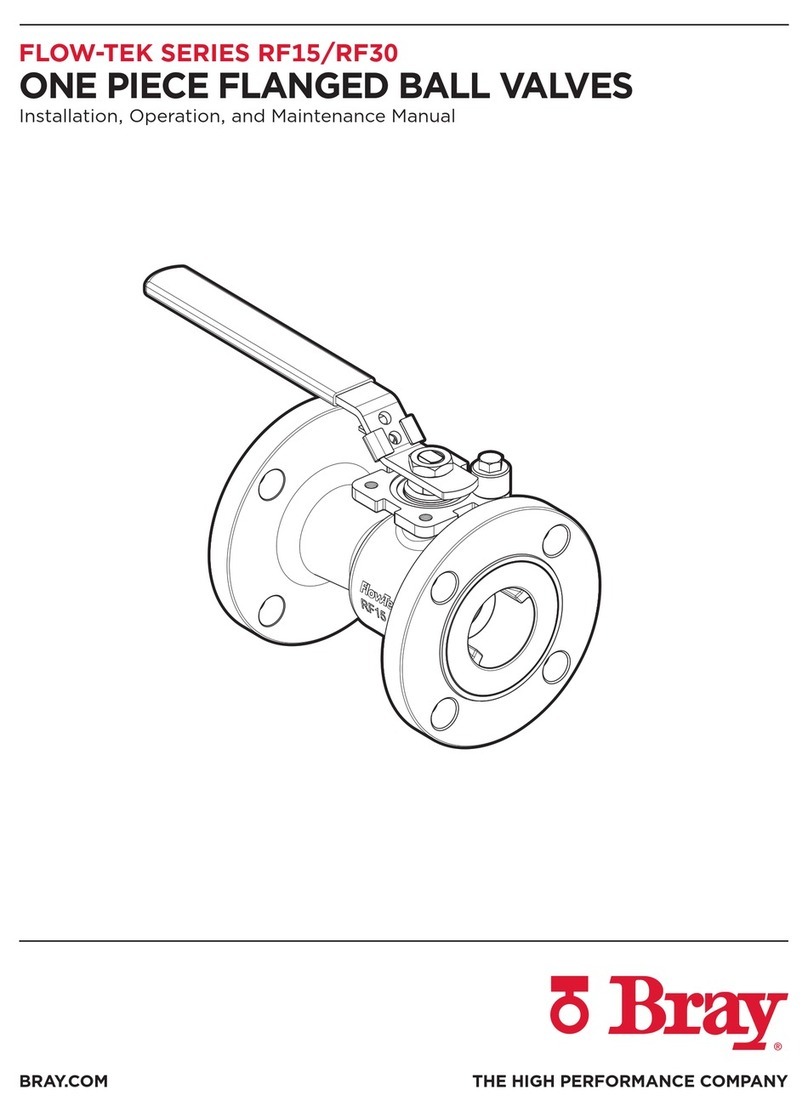
Bray
Bray FLOW-TEK Series User manual
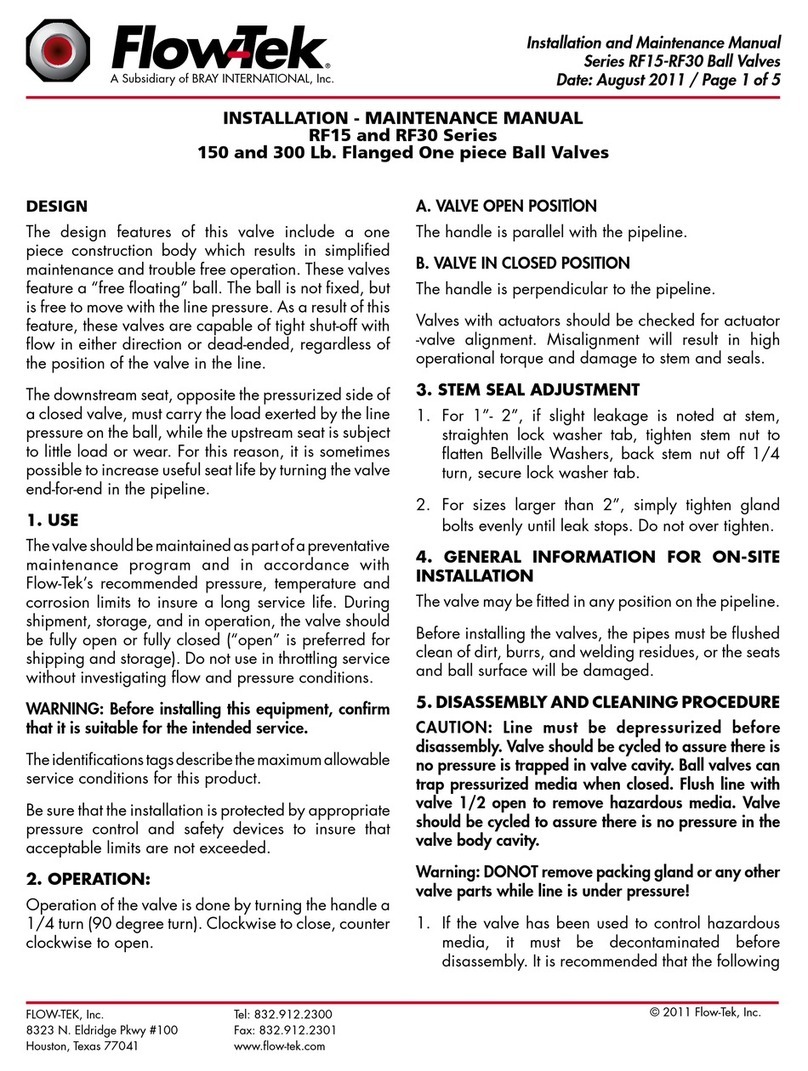
Bray
Bray RF15 Manual
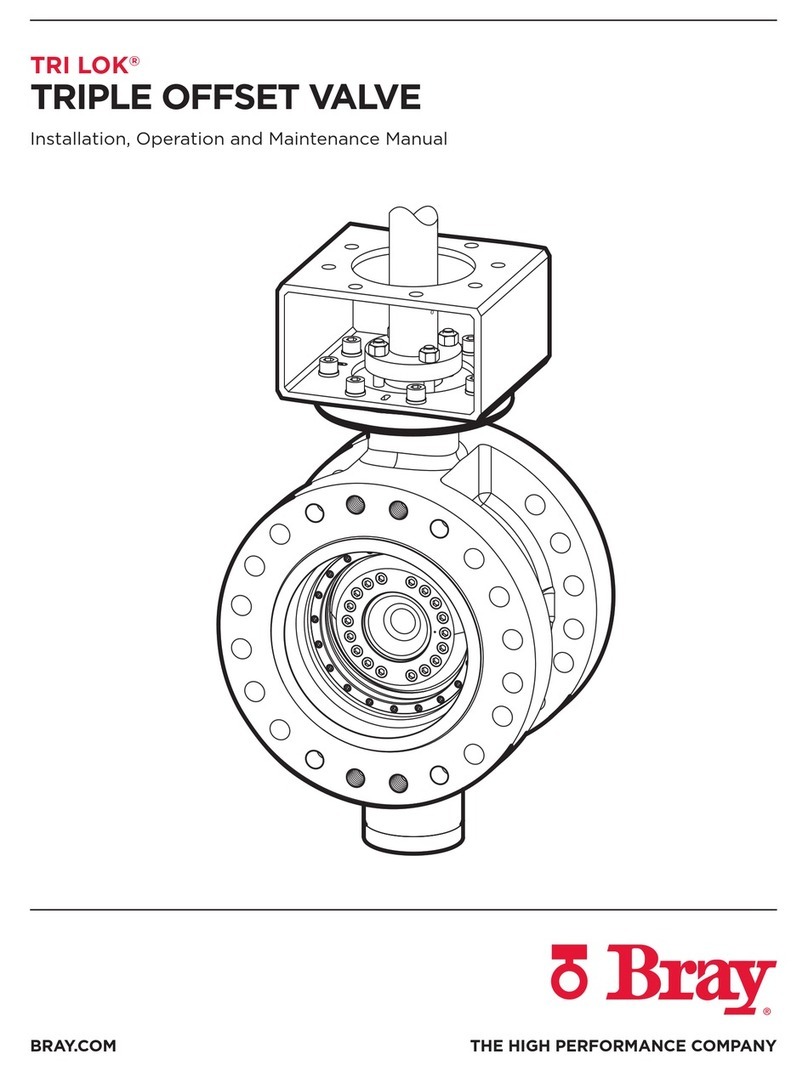
Bray
Bray TRI LOK User manual

Bray
Bray FLOW-TEK Series User manual
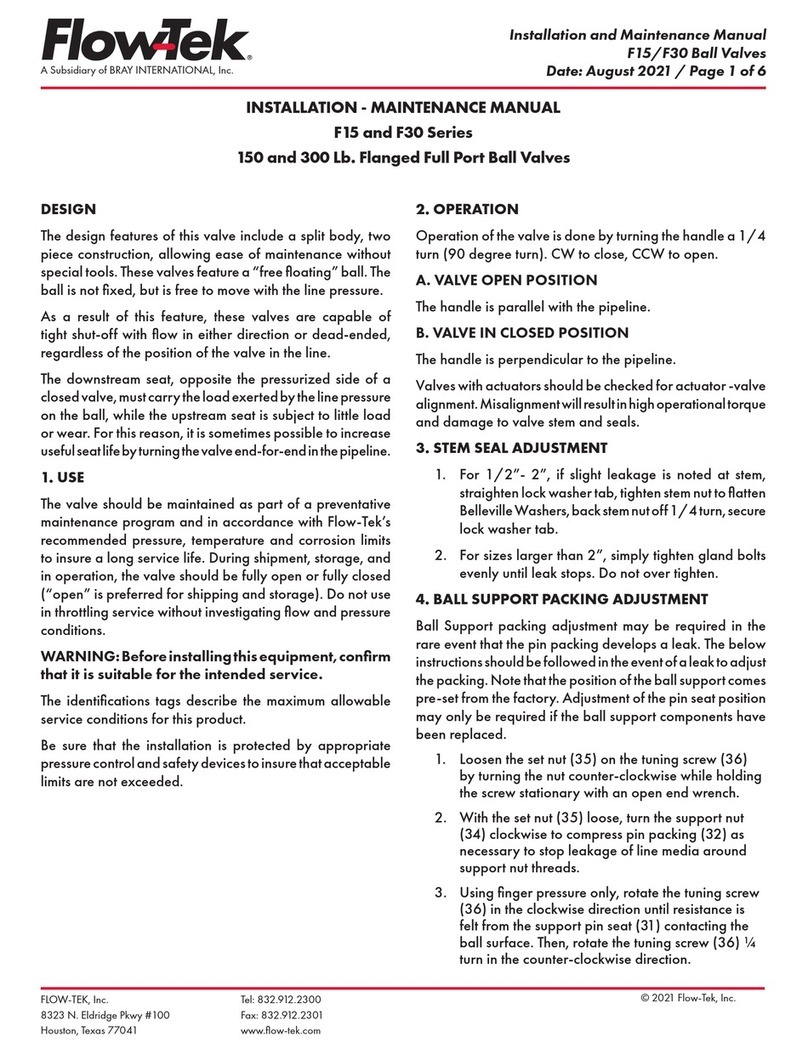
Bray
Bray FlowTek F15 Series Manual

Bray
Bray TRI LOK User manual
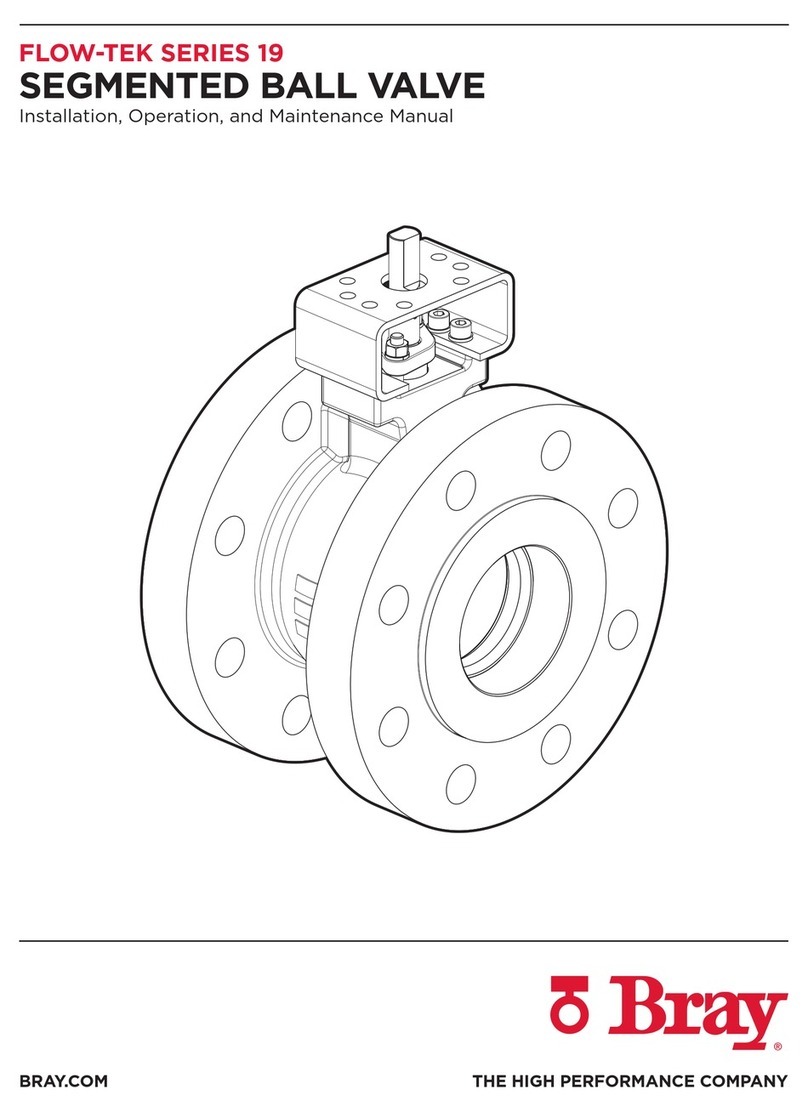
Bray
Bray FLOW-TEK 19 Series User manual

Bray
Bray TRI LOK Class 150 User manual
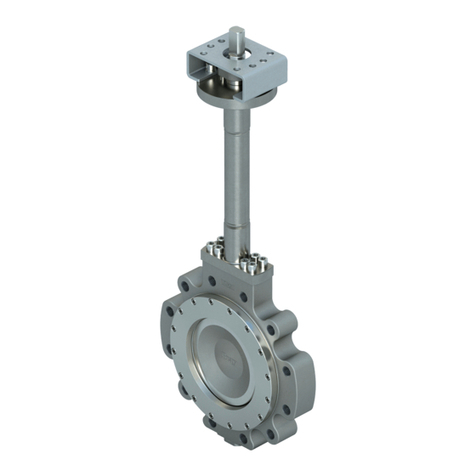
Bray
Bray McCANNALOK Series User manual

Bray
Bray RF15 Instruction Manual
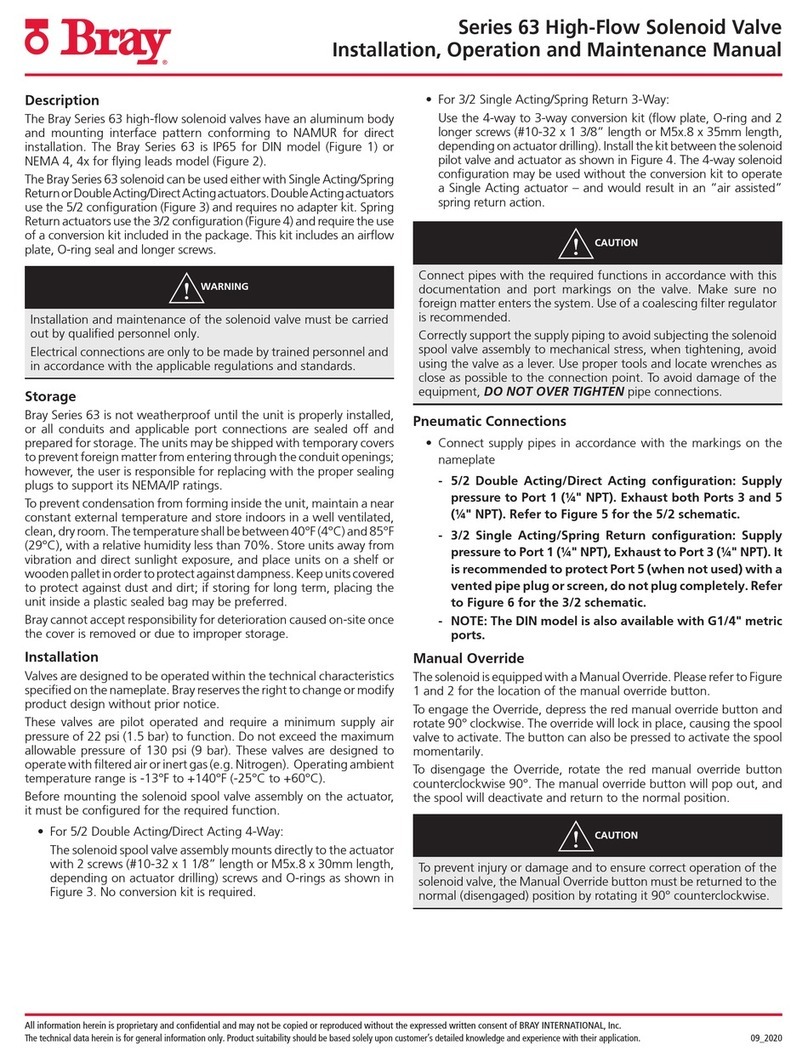
Bray
Bray 63 Series User manual

Bray
Bray TRI LOK User manual
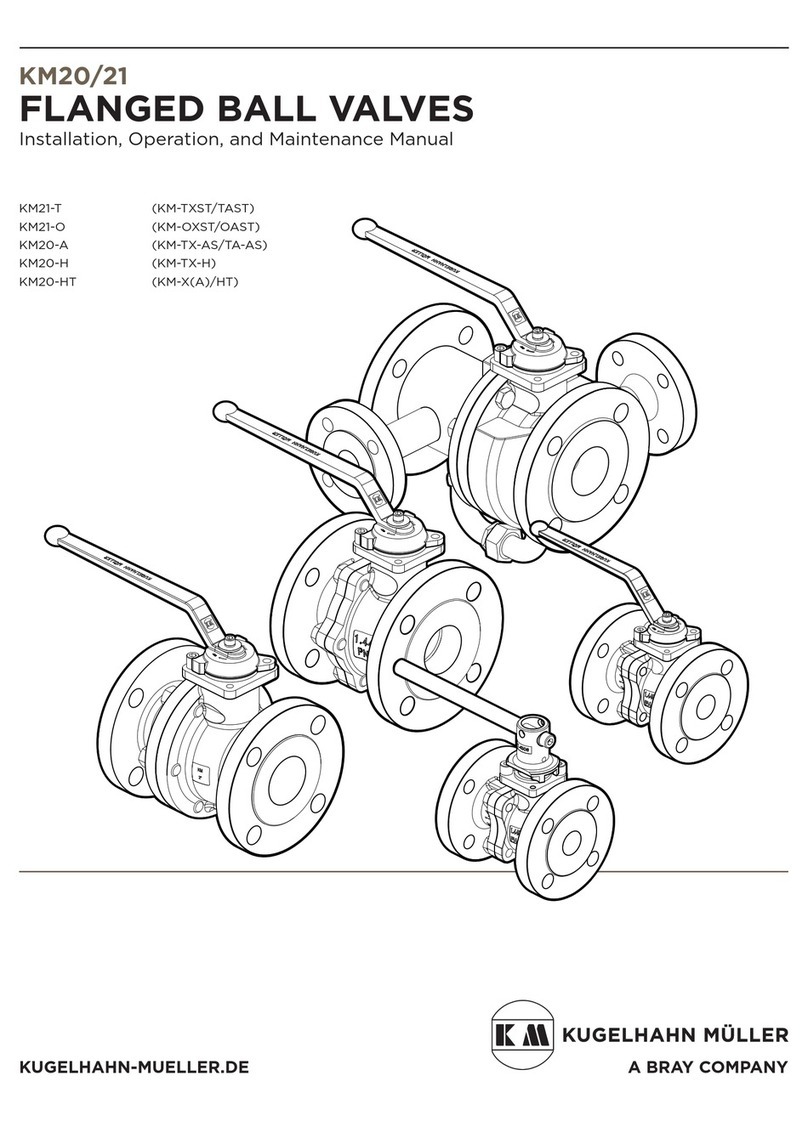
Bray
Bray KUGELHAHN MULLER KM20 User manual
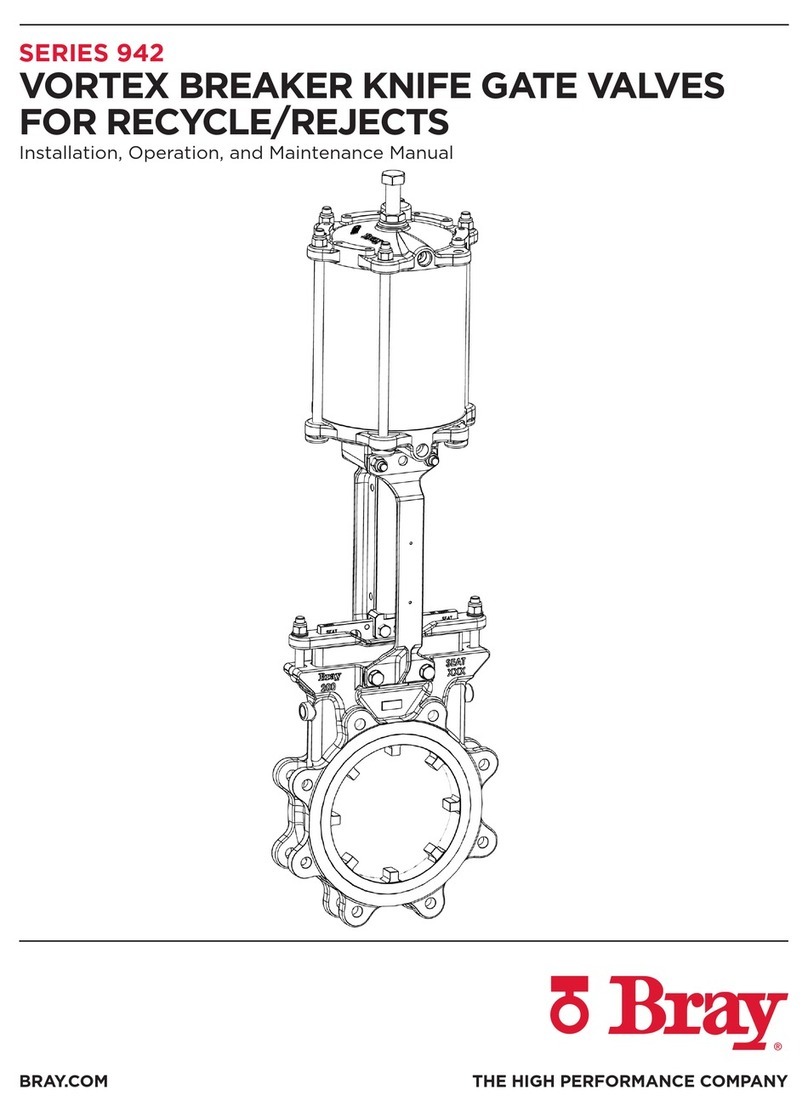
Bray
Bray 942 Series User manual
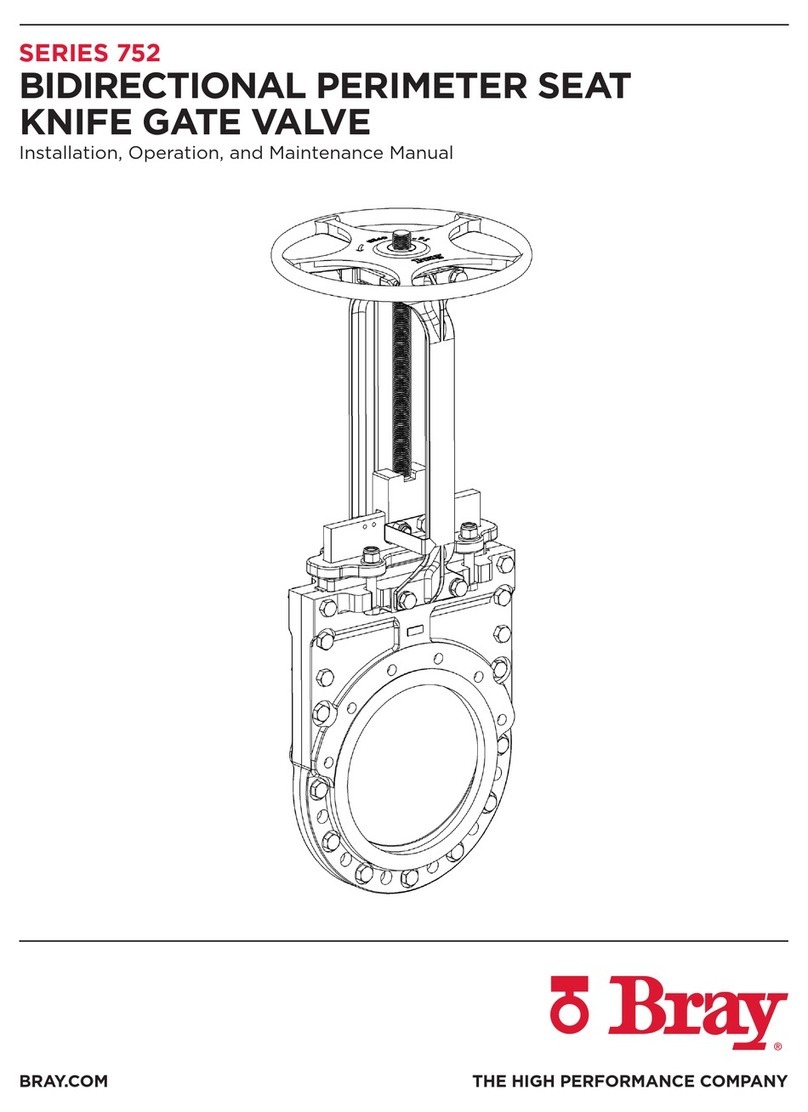
Bray
Bray 752 Series User manual
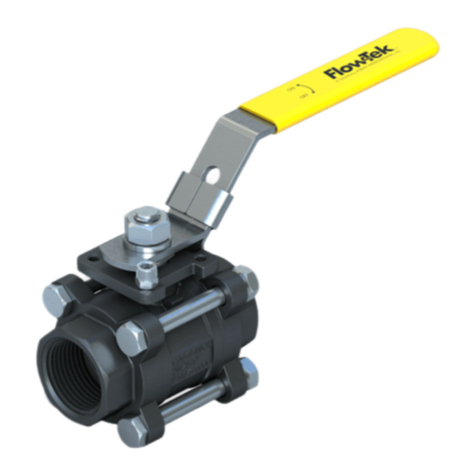
Bray
Bray Flow-Tek 5000 Series User manual

Bray
Bray 19L Series User manual
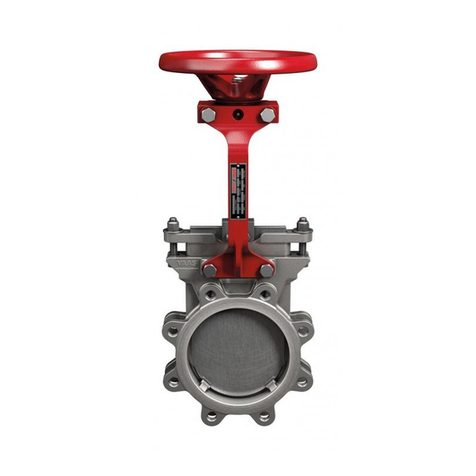
Bray
Bray 940 Series User manual
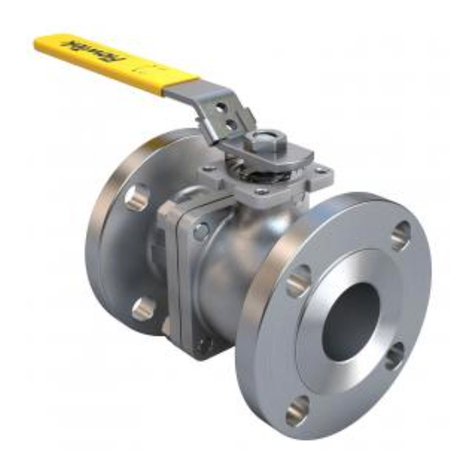
Bray
Bray FlowTek F15 Series User manual

Bray
Bray TRI LOK User manual
